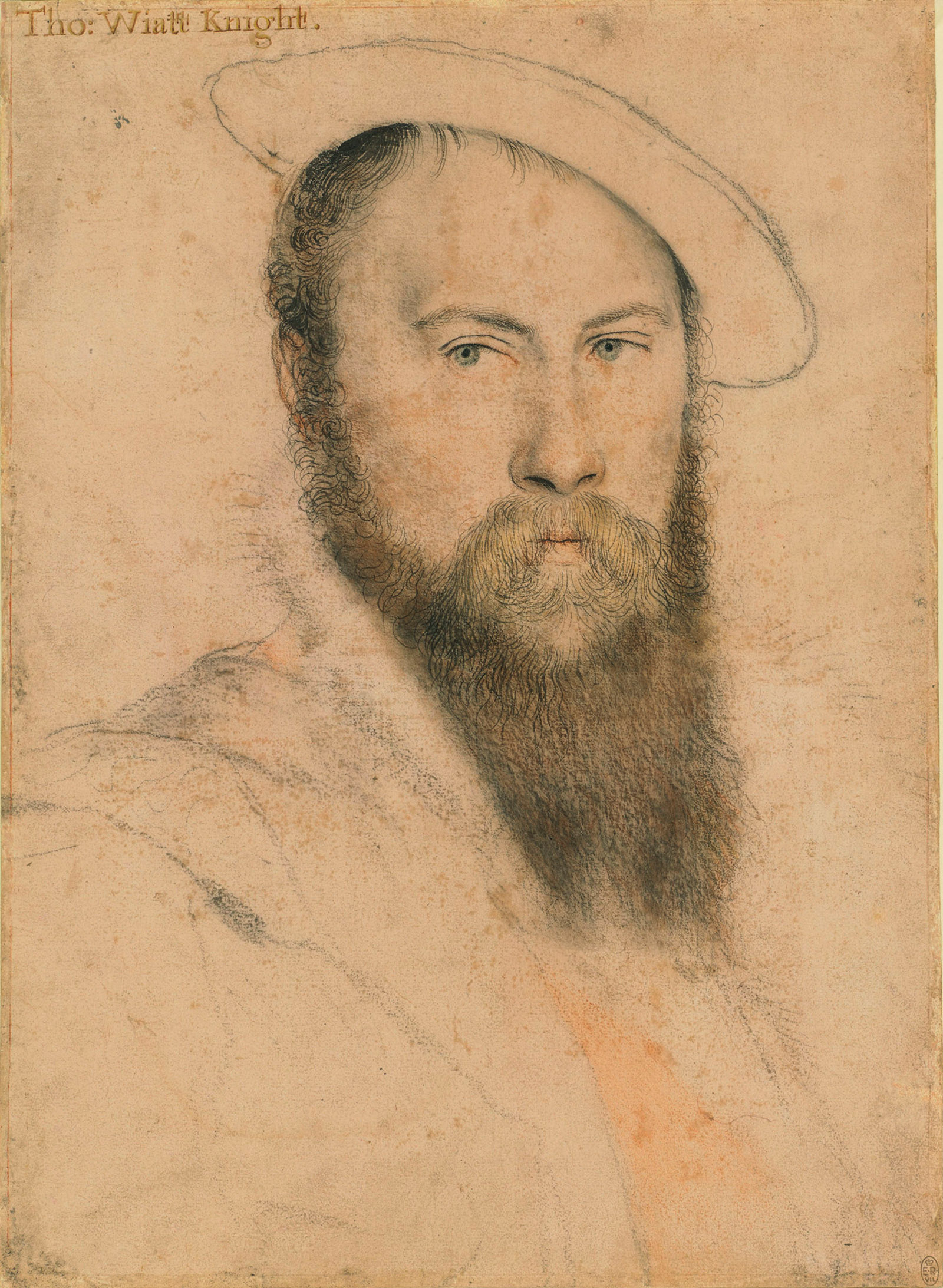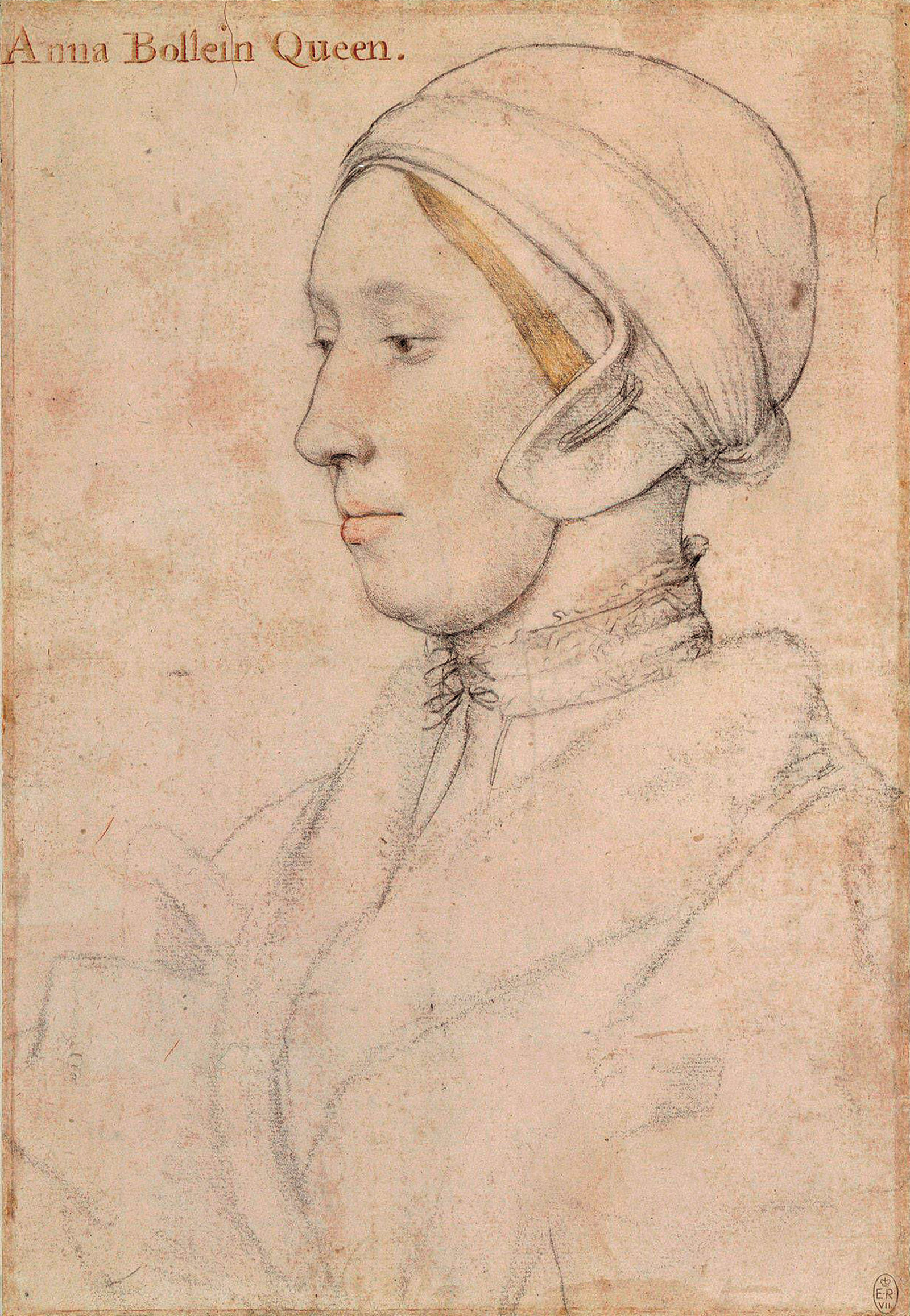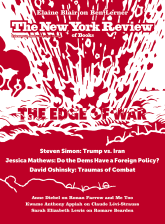Sometime around 1535, Sir Thomas Wyatt, a poet and ambassador in the court of King Henry VIII, had a scribe copy into his personal commonplace book a poem that Wyatt had composed. The text was centered on the page and written out in “Secretary Hand,” an elaborate formal script often used for legal documents, in part because it was difficult to forge. Wyatt appears to have carried the book along with him on his diplomatic business all across Europe: its one hundred or so poems, including some of the most important English lyrics before Shakespeare, were written down and revised over time, in several hands and varieties of ink. Wyatt likely kept it by his side while in the Tower of London, where he was imprisoned in 1536 for adultery, and where—according to legend—he witnessed the execution of his lover, Anne Boleyn. He was probably carrying the book when he died of a fever in 1542, at the age of thirty-nine; his son, the rebel Thomas Wyatt the Younger, inherited the book, and passed it on to other members of his father’s circle before he was executed in 1554. The book is known as the Egerton manuscript, and now resides at the British Library.
“They Flee from Me” (the title was assigned by later editors) is one of fifty-nine poems in Wyatt’s notebook that he signed with his abbreviated signature, “Tho.,” in the margins. It is arguably the greatest English lyric poem of the sixteenth century. The poem has been mislaid and rediscovered many times in its history, but it survived its brushes with oblivion to become part of the foundation of English poetry. Wyatt’s notebook, with his own version of the poem, ended up in the hands of a friend and ally, Sir John Harington, who seems to have used it partly as scrap paper (the page containing “They Flee from Me” has math problems scrawled in the margin); an altered version, copied down during Wyatt’s lifetime by a member of his coterie, exists in a separate notebook. Still another, perhaps originating from Wyatt’s own draft, was published in 1557 in Richard Tottel’s Songs and Sonnets (often referred to as his Miscellany), the best-selling Elizabethan anthology.
In the eighteenth century, Wyatt’s notebook resurfaced when a member of the Harington family, capitalizing on a sudden demand for volumes of old poetry, found it mildewing on the shelves and passed it to Bishop Thomas Percy, an anthologist and friend of Samuel Johnson who was editing a new edition of Tottel’s Miscellany. In the twentieth century, a young Cleanth Brooks, who became a Yale professor and critic, helped edit Percy’s correspondence, and included “They Flee from Me” in his legendary textbooks An Approach to Literature and Understanding Poetry (the latter coauthored with Robert Penn Warren). All these branching tributaries flowed out of and back into a single poem, which nevertheless existed, for much of this time, underground.
“They Flee from Me” is still routinely taught in the early weeks of English literature surveys like the one I teach at Wellesley. I often introduce the poem by pointing students to a highlight in its second stanza: a specimen of quoted speech so uncannily intimate that it feels as though it was whispered directly into our ears from across the centuries. The poem can be found online in its entirety, but here is that magnificent second stanza, in which Wyatt, a courtier now worryingly out of favor, recalls a lover’s vanished tenderness:
Thanked be fortune, it hath been
otherwise,
Twenty times better; but once in
special,
In thin array after a pleasant guise
When her loose gown from her
shoulders did fall,
And she me caught in her arms
long and small,
Therewithall sweetly did me kiss
And softly said, “dear heart, how
like you this?”
There’s nothing in English literature quite like that moment of five-hundred-year-old pillow talk: “Dear heart, how like you this?” The shiver that line provokes in readers was first felt by Wyatt. He cannot believe such pleasure was ever his to possess, nor can he quite fathom that its powerful memory can be revived by a mere quotation. After a stanza break that suggests temporary speechlessness, he returns, only to underscore his own amazement: “It was no dream: I lay broad waking.” The final stanza is in the key of aftershock.
Peter Murphy’s The Long Public Life of a Short Private Poem: Reading and Remembering Thomas Wyatt is the story of how a twenty-one-line poem has persisted for five hundred years, despite the vagaries of power and taste. Something already lost—that snippet of reported speech—was recovered when Wyatt first composed the poem. From that moment forward, the poem, carrying the delicate freight of that quotation, entered culture, which, over time, scuttles much more than it keeps. T.S. Eliot, in “East Coker,” described “the fight to recover what has been lost/And found and lost again and again: and now, under conditions/That seem unpropitious.” The conditions are always unpropitious for a lyric poem on a private subject by a long-dead aristocrat, and what looks like recovery sometimes entails significant loss. This paradox is in the poem itself, which memorializes a moment and a voice it also marks as cruelly and abruptly vanished. Almost as soon as it was written down, readers of the poem sometimes preserved it while stripping parts away. As Murphy vividly describes it, Wyatt’s unruly, individuated presence, inscribed in the tiny formal and rhetorical choices he made, set his poem apart from many merely proficient poems on similar subjects that circulated at the time.
Advertisement
This distinctiveness also imperiled it. In Wyatt’s personal copy, the poem lacks punctuation; it is up to readers of that version to “assign the performance part,” as Murphy writes, based on an interpretation of the poem. Even in its original form, it cries out for readers’ interventions. When “They Flee from Me” soon became a standard in courtly life, others copied it down in their own commonplace books and added punctuation wherever it seemed to fit. Editors changed Wyatt’s words and regularized his notoriously “rough” prosody. Before it was a masterpiece, the poem was therefore a much-remodeled “house for thought,” according to Murphy. It was a platform for readers’ customizations and modifications. Every time it was covered, like a pop song, it was changed. “Poetry,” wrote the scholar and poet Allen Grossman, “pitch[es] persons toward one another full of news.” In these smudged forms, the poem lost part of its occult power to convey that news across the span of years.
The poem presented other impediments to longevity. It is, first of all, one of a kind. Though it uses the fashionable meter, popularized by Chaucer, called rhyme royal, it has no real predecessor in the art. It does not sound much like Wyatt’s other poems—though his famous sonnet “Whoso List to Hunt” (adapted from Petrarch’s Rime 190) is nearly as good and nearly as anguished. Wyatt was the John Kerry of his day: his poetry was, as Murphy points out, a kind of statecraft, a demonstration of his worldly prowess. It eschews many of the conventional scenarios of the love lyric. Love poems, if Wyatt’s even counts as one, are primarily useful for wooing. What keeps them alive is often their power to entice a person to go to bed with you, or to keep them in bed despite their contesting obligations, or to lure them back into bed once, distressingly, they’ve moved on. This is a timeless, highly pragmatic feature of poetry, and no less true for poems written yesterday.
Wyatt’s poem, though, cannot really be used as a script for courting. He describes his lover’s charms in the third person; this is no way to woo somebody. The poem also cedes all sexual power to a beloved who is now mysteriously and irretrievably gone. This goes far beyond the feigned powerlessness or playing dead of the usual courtier planning a sneak sexual conquest. The poem is, instead, about a fluke, something isolated and bobbing in time, like a raft in the middle Atlantic. This is why there’s that math in Wyatt’s poem: though he is abandoned now, his state has been “otherwise” twenty times, but “once in special.” The conventional arc of a poem so richly invested in its speaker’s rejection would end in a desperate plea for the beloved to return. For a self-styled courtier of a few decades later, like the hapless Abraham Slender in Shakespeare’s Merry Wives of Windsor, the poems in Tottel’s Miscellany were a script: “I had rather than forty shillings,” Slender exclaims when Anne Page enters, “I had my Book of Songs and Sonnets here.” But “They Flee from Me” is too gnarled and remorseful, too strange, too embittered, to help a lover in a bind.
The indirection of “They Flee from Me,” which may be its most modern (and modernist) feature, originally served a tactical purpose. Wyatt’s poem was a public demonstration that he possessed not merely verbal power and wit, but also information and tact. “The filtering of the personal through an inherited, continuing culture is the very essence of lyric poetry,” writes Murphy. The power of Wyatt’s poem arises not only from its ingenious manipulation of known and finite conventions, but from its out-of-nowhere portrayal of unsettling “linguistic and psychological drama” where members of the court expected much more reflexive “repetition and listing,” as in a sing-along. This is how a poem designed by a star player in a long-lost, often lethal cultural game both fulfilled and undermined its immediate application in the world of the Tudor court. His aristocratic circle of readers was tiny: “on the order of tens,” according to Murphy. The pronouns “they” and “she” would have suggested to these readers possible living antecedents. The poem’s cunning was a form of self-defense. For modern readers, these kinds of layers of calculation, broken by intermittent directness or frankness, have come to be synonymous with lyric poetry itself.
Advertisement
Even half a millennium later, the poem has some of the illicit freshness of gossip. “They Flee from Me” acts as though it possesses secrets that might be deciphered by a coterie reader, even one encountering it across the centuries. To the noble ladies and gentlemen who were its intended audience, some of whom would soon be executed by Henry VIII, the “she” whose unforgettable remark still echoes in our ears might have suggested Anne Boleyn herself. Wyatt’s coded, deniable disclosures of an affair with the queen can be found elsewhere in his work—in “Whoso List to Hunt” and in a tantalizing epigram: “What word is that, that changeth not,/Though it be turned and made in twain?” The answer, which Wyatt gives in the next line, is “Anna.” The riddle is in one sense solved, but the narrow answer does nothing to dispel the darker and more lurid mystery it implies. “Anna” is a name Anne Boleyn sometimes used in correspondence, and the Latinized form of her name, Anna Bolina, appears under many of her formal portraits. Though changed into Anna, Anne “changeth not.” Wyatt’s affair with Boleyn is still, so far as I know, a matter of hearsay. On Wyatt’s Wikipedia page, a subheading is labeled “Rumoured Affair with Anne Boleyn.” The rumors that the poem keeps alive in turn keep it alive.
For a citizen of the Long Twentieth Century like Murphy (and like me), “They Flee from Me” carries a distinct provenance, one that may be lost on my students. As Murphy suggests, it is one of the central poems of the New Criticism, the influential critical practice that came to dominate English departments after World War II. The New Criticism was a method of formal analysis, but also a canon of texts, primarily lyric poems, upon which the method could be especially vividly demonstrated. While its core method has hung on in the form of “close reading,” which has proved durably essential to the work of the literary classroom, its canon, which was almost exclusively white and male, has not. The prestige of the lyric poem in the mid-twentieth century depended upon its being a repository of delicate ironies and “multiple meanings,” which could be tweezed out by eager undergraduates before the bell rang.
The methods of the New Criticism, as consolidated in books like Cleanth Brooks’s An Approach to Literature, borrowed from science a rational, evidentiary approach to poems. We value literature for “what sort of information it gives,” according to Brooks’s introduction to his textbook, and “how it is related to, and how it differs from, scientific information.” These discriminations are to be made by looking always at “a concrete case.” The rhetoric of demonstrable, empirical “value” replaced the kind of language a student might have encountered in a competing textbook, The College Omnibus: “The wish to spread the contagion of beauty, whether it be the play of the fancy or the emanation of truth, is the deepest reason for poetry.” The idea that beauty could be “spread” like a sexually transmitted disease would not have struck students as odd if they hadn’t been trained to detect, under words like “contagion,” something bizarre, perhaps unintended (or not—which is worse?), some undeclared spillover of meaning. Brooks’s textbook provided such training.
In the classroom, the New Criticism standardized the experience of literature at a time when elite colleges were being opened up to white men and women from a wider range of socioeconomic backgrounds. Literature was a new language, taught like any other, with a rigorous first course in its grammar and vocabulary. Up to that point, English Literature had been an aura, or a cologne, or an accessory for gentlemen. At Amherst College, Theodore Baird, one of the sentinels of applied New Criticism, recalled a literature professor of the older guard, David Morton:
He was a boxer and he would box with his students…. I can remember once he came into the locker room after having boxed with some student or other and he wasn’t able to speak because he had been hit so hard on the jaw it was numbed…. He taught a senior course on Modern Poetry, only he didn’t call it Modern Poetry: he called it Moods of the World Today.
The cat’s cradle of meanings created by a poem like “They Flee from Me” might have been lost on students in “Moods of the World Today,” though its narrative would have appealed to Morton, who “cultivated nostalgia and liked the idea of meeting ladies in the dark and talking with them and then never seeing them again.”
But in other ways, “They Flee from Me” is a terrible candidate for a New Critical interpretation, partly because the New Criticism sees every aspect of a poem on a single, nonhistorical plane. All the “multiple meanings” have to be there at one time. The study of history is deemed irrelevant. The story of the poem’s unlikely survival in the wilds of scholarship would probably not have been introduced. Wyatt’s tactical cunning, entirely an artifact of his time and place—a means of self-preservation in the Tudor court—might have been flattened and turned into “wit,” a virtue valuable for surviving department parties. Murphy’s chapter on the New Criticism suggests, in fact, how literature professors in midcentury American classrooms swelled by World War II veterans turned their own operations on poems into a kind of statecraft. They were professor-soldiers, and the sprezzatura could be felt in the room. It was still the case when I was a student that some of the senior and retired members of English departments were said to have honed their craft by deciphering Nazi code. At Harvard in the 1990s, before the arrival of Stephen Greenblatt, the person who knew the most about Wyatt was the distinguished scholar Gwynne Evans, a kind, by then elderly man with an office in Widener Library full of antiquarian books that he gave away to grad students. Evans had worked at Bletchley Park and was instrumental in cracking the Enigma Code.
Murphy’s book ends before our current era in literary instruction, which is a shame. His own insights must have been gathered from decades of teaching the poem at Williams College, but his classroom experience, which is itself a crucial part of the long tale of “They Flee from Me,” is left mostly implicit. The publication of this volume is surely the biggest thing to happen to Wyatt’s poem in at least a few generations. What led Murphy to make this extraordinary intervention in its story? For that matter, what has led me to read and consider Murphy’s book, and to write this review? Elite literary classrooms are now in the vanguard of social change. What does Murphy say to his Williams students when they ask—as my Wellesley students ask me—about a poem in which, sure, a man gives power to a woman, but doesn’t he retain it as his to give away in the first place? What does he say to a student who rejects not only Wyatt’s original scenario of love and loss, but the pedagogical scenario in which the poem is introduced? I stammer out my hand-me-down New Critical pieties about multiple meanings, but what I’m really thinking about is, why this poem, and why this poem now? The abrupt ending of Murphy’s one-of-a-kind study leaves us all to answer the question.





